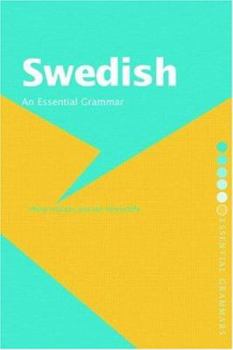Swedish: An Essential Grammar
Select Format
Select Condition 
Book Overview
This fully revised second edition of Swedish: An Essential Grammar incorporates a large number of changes of detail and examples throughout, all made with the aim of clarifying the explanations and... This description may be from another edition of this product.
Format:Paperback
Language:English
ISBN:0415160480
ISBN13:9780415160483
Release Date:June 1997
Publisher:Routledge
Length:216 Pages
Weight:0.80 lbs.
Dimensions:0.6" x 6.2" x 9.1"
Customer Reviews
4 ratings
Swedish: An Essential Grammar (Routledge Grammars)
Published by Thriftbooks.com User , 18 years ago
A really good tool containing concise and well organised material.
Great tool for learning grammar
Published by Thriftbooks.com User , 18 years ago
Basically, when you finish this book, you will have the groundwork laid for speaking Swedish.
Excellent concise grammar
Published by Thriftbooks.com User , 21 years ago
This is a very well written, interesting, informative, and concise grammar of Swedish. For the hard-core linguist, there is also the Comprehensive Grammar published by Routledge at 95 bucks by Holmes, but this one will do for most people, expecially since it's about 1/6 the price.I learned a lot about Swedish from this book, and it was fun reading it as the similarities between English and Swedish are still very much in evidence. The two languages still share many features in common. Here are some of the ones that I learned from this book:1. There are two levels of syllabic stress in Swedish and four in English. This gives Swedish it's sing-song quality.2. Many words are the same or almost the same. (However, note that the vowel diacritical marks in the Swedish words can't be shown). These words include: fot (foot), finger (finger), gras (grass), hus (house), kna (knee), lamm (lamb), oss (us), skarp (sharp), son (son), tva (two), tre (three), and vi (we). 3. Both have only the nominative and genitive cases:skepparen i baten (the skipper of the boat)skepparens katt (the skipper's cat)4. Both have subject and direct object forms for pronouns:vi (we)oss (us)5. The have similar ways of distinguishing adjectives and adverbs:dyr (dear)dyrst (dearest)6. There are similar methods for comparing adjectives with inflectional endings:fet (fat)fetare (fatter)fettest (fattest)7. Without inflectional endings, they look like this:mer typisk (more typical)mest typisk (most typical)8. Both have weak verbs with dental endings: (i.e., "d" and "t" in the past tense)vi cylcade (we cycled)de kysste mig (they kissed me)9. Both have strong verbs with internal vowel changes in the past tense:vi sitter (we sit)vi satt (we sat)10. The languages have similar auxiliary verbs:kan, ska, maste (can, shall, must)de kan komma (they can come)11. Verb tenses are very similar: vi ar har nu (we are here now)han har redan kommit (he has already arrived)12. They have similar use of the formal subject:det ar kallt har (it is cold here)dett finns ett museum dar (there is a museum here)13. Both have inverted (verb-subject) word order for questions:var ar vi? (where are we?)ar du sjuk (are you sick?)14. Both have only pre-positional adjectives:em warm sommar (a warm summer)den warma sommaren (the warm summer)However, lest I give the impression that the languages are exactly alike, I should mention some some important differences between Swedish and English. Swedish is entirely phonetic, whereas English is not. Swedish main clause word order is much more labile and flexible than in English. The sentence often begins with word or words that are not the actual subject, and subject and sentence elements can appear in different positions in both dependent and independent clauses.Nouns have gender in Swedish, but they are either neuter or non-neuter, which is different from the Romance languages, where they are female
Finally, a comprehensive Swedish grammar.
Published by Thriftbooks.com User , 24 years ago
I have heard even Swedes complain that there is no readily available comprehensive grammar of the language. Now Routledge's "Comprehensive Grammar" series and their "Essential Grammar" series are filling niches long empty. The "Comprehensive" grammars, such as this one, are reference works for students who have some knowledge of the language and want full explanations of the main points as well as full lists of irregularities and explanations of the niceties of usage. This is information that no other Swedish book I know of provides.The beginning student should consult the Foreign Service Institute's course, or Assimil's "Le suedois sans peine," or books and recordings offered by American universities, or perhaps Linguaphone's Swedish course. Use this comprehensive grammar as a supplement and as a reference for times when standard textbooks leave doubts.





